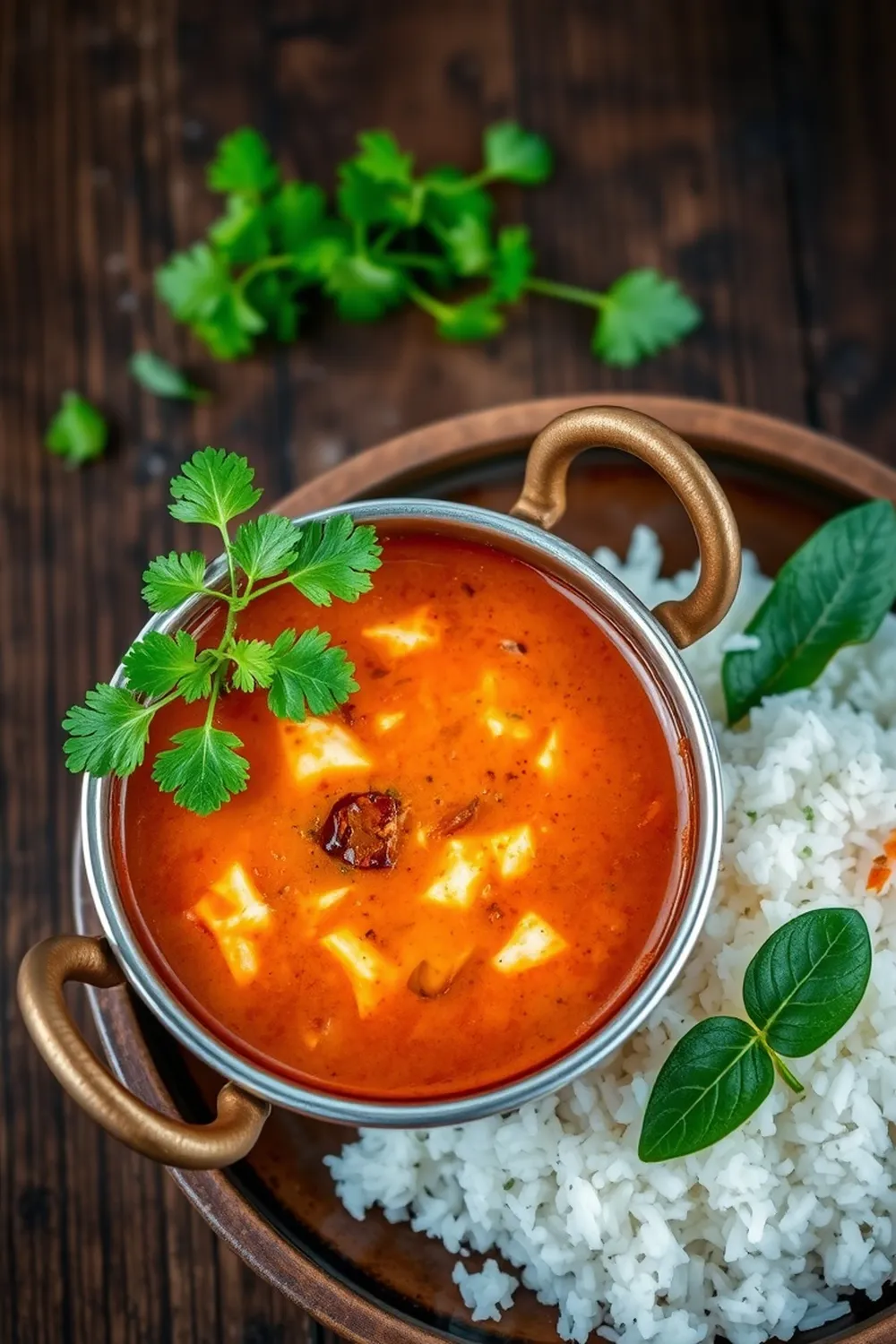- Blanch tomatoes in boiling water until the skin loosens, then peel, strain, and reserve the stock.
- Blend the peeled, cooked tomatoes with coconut, green chilies, and cumin to a smooth paste.
- Combine the paste with the reserved stock and water in a pan. Add jaggery and salt to taste.
- Heat oil in a small pan (tadka pan). Temper mustard seeds, cumin seeds, curry leaves, dried red chili, turmeric powder, and asafoetida.
- Pour the tempering into the saar mixture. Cover and simmer to infuse flavors.
- Garnish with fresh coriander leaves and serve hot with steamed rice.
- Calories:120 kcal25%
- Energy:502 kJ22%
- Protein:2 g28%
- Carbohydrates:12 mg40%
- Sugar:6 mg8%
- Salt:150 g25%
- Fat:8 g20%
Last Updated on 5 months ago by Neha Deshmukh
Tomato Coconut Saar Recipe – Authentic South Indian Curry
Hey everyone! If you’re anything like me, you absolutely love a good, comforting curry. And today, I’m sharing a recipe that’s been a family favorite for years – Tomato Coconut Saar. It’s a light, tangy, and incredibly flavorful South Indian curry that’s perfect with a steaming plate of rice. I first made this when I was trying to recreate my grandmother’s cooking, and honestly, it’s been a go-to ever since!
Why You’ll Love This Recipe
This Tomato Coconut Saar isn’t just delicious; it’s also surprisingly easy to make. It’s a wonderful introduction to South Indian flavors, and it’s a fantastic way to use up ripe tomatoes. Plus, it’s naturally vegan and gluten-free (more on that later!). You’ll love how the sweetness of the coconut and jaggery balances the tanginess of the tomatoes and the warmth of the spices.
Ingredients
Here’s what you’ll need to make this amazing saar:
- 250 grams tomatoes
- 1.5 cups water
- 0.5 cup coconut (fresh or desiccated)
- 2-3 teaspoons green chilies (adjust to your spice preference!)
- 0.5 teaspoon cumin seeds
- 0.5 teaspoon jaggery (or brown sugar)
- 2 tablespoons oil
- 0.5 teaspoon mustard seeds
- 0.25 teaspoon cumin seeds
- 8-10 curry leaves
- 1 dried red chili
- 0.25 teaspoon turmeric powder
- 1 pinch asafoetida (hing)
- 2 tablespoons coriander leaves, chopped
Ingredient Notes
Let’s talk ingredients! Fresh, ripe tomatoes are key here – they give the saar its beautiful color and flavor. I prefer using Roma tomatoes, but any good quality tomato will work.
Coconut is another star. Freshly grated coconut is amazing if you can get it, but desiccated coconut works perfectly well too. Just make sure it’s unsweetened.
And don’t skip the South Indian spices! Asafoetida (hing) might seem a little unusual, but it adds a unique savory depth. Curry leaves are also essential for that authentic flavor. Spice levels can vary hugely depending on the region – some families like it fiery hot, others prefer a milder touch. Feel free to adjust the green chilies to your liking!
Step-By-Step Instructions
Alright, let’s get cooking!
- First, boil the tomatoes in the water until they’re nice and tender. This usually takes about 5-7 minutes. Once they’re cooked, strain them, but save that tomato water – it’s liquid gold!
- Now, blend the cooked tomatoes with the coconut, green chilies, and cumin seeds until you have a super smooth paste. A good blender is your friend here.
- Pour the tomato-coconut paste back into a pan, along with the reserved tomato water and a little extra water if needed. Add the jaggery and salt. Bring it to a simmer.
- While the saar is simmering, let’s make the tadka (tempering). Heat the oil in a separate small pan (a tadka pan is ideal, but any small pan will do). Add the mustard seeds and let them splutter. Then, add the cumin seeds, curry leaves, and dried red chili. Fry for a few seconds until fragrant, then add the turmeric powder and asafoetida. Be careful not to burn the spices!
- Pour the hot tadka into the saar. It will sizzle and pop – that’s a good sign! Cover the pan and let it sit for a few minutes to allow the flavors to meld together.
- Finally, garnish with fresh coriander leaves and serve hot with steamed rice. Seriously, it’s that good.
Expert Tips
- Don’t be afraid to adjust the water to get the consistency you like. Some people prefer a thicker saar, others like it more watery.
- If you don’t have jaggery, you can use brown sugar as a substitute.
- The tadka is crucial for the flavor, so don’t skip it!
Variations
- My friend Priya loves adding a small piece of tamarind to her saar for extra tanginess.
- For a richer flavor, you can add a tablespoon of ghee (clarified butter) to the tadka.
- My family sometimes adds a handful of chopped onions to the saar while it’s simmering.
Vegan Adaptation
Good news – this recipe is already vegan! No modifications needed.
Spice Level Adjustment
- Mild: Use 1 green chili or remove the seeds from the chilies.
- Medium: Use 2-3 green chilies.
- Hot: Use 4-5 green chilies or add a pinch of cayenne pepper.
Festival Adaptations
Tomato Coconut Saar is often made during Onam and other South Indian festivals as part of a traditional sadya (feast). It’s considered a very auspicious dish.
Gluten-Free Option
This recipe is naturally gluten-free!
Serving Suggestions
This saar is best served hot with steamed rice. It also pairs well with roti or appam. A side of papadums adds a nice crunch.
Storage Instructions
Leftover saar can be stored in an airtight container in the refrigerator for up to 3 days. Reheat gently on the stovetop or in the microwave.
FAQs
What is Saar and how is it different from other South Indian curries?
Saar is a thin, tangy, and flavorful curry, typically made with tamarind, tomatoes, or kokum. It’s lighter than many other South Indian curries, which tend to be thicker and richer.
Can I use canned tomatoes instead of fresh tomatoes?
Yes, you can! Use about 400 grams of canned crushed tomatoes. Just be aware that the flavor might not be quite as vibrant as with fresh tomatoes.
What is the best type of coconut to use for this recipe?
Freshly grated coconut is ideal, but unsweetened desiccated coconut works great too.
How can I adjust the sourness/sweetness of the Saar?
Add more jaggery for sweetness or a squeeze of lemon juice or a small piece of tamarind for sourness.
Can this Saar be made ahead of time?
Yes, you can make the saar a day ahead. The flavors actually develop even more overnight! Just add the tadka right before serving.
What is asafoetida (hing) and why is it used in this recipe?
Asafoetida is a resin with a pungent smell, but it adds a unique savory flavor to the saar. It’s often used in Indian cooking to aid digestion and add depth of flavor.







